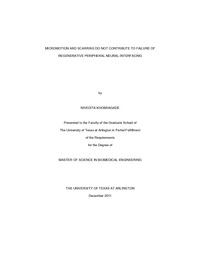
ATTENTION: The works hosted here are being migrated to a new repository that will consolidate resources, improve discoverability, and better show UTA's research impact on the global community. We will update authors as the migration progresses. Please see MavMatrix for more information.
Show simple item record
| dc.contributor.author | Khobragade, Nivedita | en_US |
| dc.date.accessioned | 2014-03-10T21:16:58Z | |
| dc.date.available | 2014-03-10T21:16:58Z | |
| dc.date.issued | 2014-03-10 | |
| dc.date.submitted | January 2011 | en_US |
| dc.identifier.other | DISS-11510 | en_US |
| dc.identifier.uri | http://hdl.handle.net/10106/24028 | |
| dc.description.abstract | Neuroprosthetics facilitate amputees with motor function restoration by interfacing nervous system with artificial limb and enabling control of the prosthetic device by volitional thought. Though such neurointerfacing provides dexterity nearly mimicking natural limb agility, the clinical viability of such prosthetics is limited by the lack of long-term reliability. In central nervous system, these implants fail due to foreign body reaction and glial scar formation around the implant. The cause of decrease in active sites of interfacing in peripheral nervous system, which is less invasive than central nervous system implantation, has not been established. Recently an open architecture, regenerative peripheral neural interface was developed which successfully records in amputated nerves as early as 7 days. A decline in the number of active electrodes is observed similar to other neural interfaces. To elucidate the cause of this decay, the tissue response was evaluated over chronic implantation of Regenerative Multi-electrode Interface (REMI) into the sciatic nerve of adult rats. Floating multi-electrode arrays comprising 18 Pt/Ir electrodes, placed in collagen-filled Polyurethane tubes, were implanted in eighteen female adult Lewis rats by suturing the stumps of transected sciatic nerve to the tube. Control animals were twelve female adult Lewis rats which were implanted with collagen-filled Polyurethane conduits lacking FMAs by similar procedure following sciatic nerve transection. Electrophysiological recordings were carried out weekly using Omniplex data acquisition system (Plexon Inc. USA). Progressive decrease in the number of functional electrodes was observed after 21 days of implantation. The REMI-implanted sciatic nerve and the L4-L5 DRGs were harvested after 15, 30 and 60 days post-implantation (n=6 for each group). Reactive macrophages visualized by immunofluorescence of ED1 labeling, showed a significant decrease in the scar area after 60 days of implantation compared to 15-day post-surgery. Macrophage cell density did not increase from 15-day to 60-day post-implantation indicating that the scar area did not compact with time. Electrophysiological recordings were obtained at 15 days when inflammatory response had already encapsulated the electrode site suggesting that macrophage scar does not play a role in failure in recording capability of electrodes. Transcription factors ATF3 Activating Transcription Factor-3 and c-Jun, which are upregulated during nerve injury, were also assessed to determine if the electrodes were causing neuronal damage due to micromotion. ATF3 expression levels in REMI implanted animals had significantly reduced after 60 days of sciatic nerve transection compared to that after 15 days and the levels were not significantly different than control animals. cJun levels were significantly increased 60-days post-implantation compared to that at 15-days and were similar to cJun expression in control animals. This provides evidence that REMI implants form a stable interface with the regenerated nerve and are not affected by micromotion. Due to low susceptibility to micromotion, REMI interfacing does not aggravate inflammatory response or cause nerve damage at interface with chronic implantation. | en_US |
| dc.description.sponsorship | Romero-Ortega, Mario | en_US |
| dc.language.iso | en | en_US |
| dc.publisher | Biomedical Engineering | en_US |
| dc.title | Micromotion And Scarring Do Not Contribute To Failure Of Regenerative Peripheral Neural Interfacing | en_US |
| dc.type | M.Engr. | en_US |
| dc.contributor.committeeChair | Romero-Ortega, Mario | en_US |
| dc.degree.department | Biomedical Engineering | en_US |
| dc.degree.discipline | Biomedical Engineering | en_US |
| dc.degree.grantor | University of Texas at Arlington | en_US |
| dc.degree.level | masters | en_US |
| dc.degree.name | M.Engr. | en_US |
Files in this item
- Name:
- Khobragade_uta_2502M_11510.pdf
- Size:
- 20.26Mb
- Format:
- PDF
This item appears in the following Collection(s)
Show simple item record


